Podcast
Questions and Answers
What is the basic unit of matter?
What is the basic unit of matter?
- Compound
- Element
- Molecule
- Atom (correct)
Which type of bond is formed by the sharing of electrons?
Which type of bond is formed by the sharing of electrons?
- Covalent Bond (correct)
- Hydrogen Bond
- Ionic Bond
- Metallic Bond
What is the pH range of a basic solution?
What is the pH range of a basic solution?
- 7 to 14 (correct)
- 0 to 3
- 14 to 17
- 3 to 7
Which of the following is a characteristic of exothermic reactions?
Which of the following is a characteristic of exothermic reactions?
What is the primary measure of acidity or alkalinity in a solution?
What is the primary measure of acidity or alkalinity in a solution?
Which type of reaction is represented by the equation A + B → AB?
Which type of reaction is represented by the equation A + B → AB?
Which group in the periodic table contains elements with similar chemical properties?
Which group in the periodic table contains elements with similar chemical properties?
What does the Law of Conservation of Mass state about chemical reactions?
What does the Law of Conservation of Mass state about chemical reactions?
Study Notes
Basic Concepts of Chemistry
-
Matter
- Anything that has mass and occupies space.
- Exists in states: solid, liquid, gas, and plasma.
-
Atoms
- Basic unit of matter.
- Composed of protons (positive), neutrons (neutral), and electrons (negative).
- Element: a substance made of one type of atom.
-
Molecules
- Two or more atoms bonded together.
- Can be the same type of atoms (e.g., O₂) or different (e.g., H₂O).
Chemical Bonds
-
Ionic Bonds
- Formed through the transfer of electrons.
- Typically between metals and nonmetals.
-
Covalent Bonds
- Formed by sharing electrons between atoms.
- Common in nonmetals.
-
Metallic Bonds
- Involves the pooling of electrons in metals.
- Allows for conductivity and malleability.
Chemical Reactions
-
Types of Reactions
- Synthesis: A + B → AB
- Decomposition: AB → A + B
- Single Replacement: A + BC → AC + B
- Double Replacement: AB + CD → AD + CB
- Combustion: Hydrocarbon + O₂ → CO₂ + H₂O
-
Law of Conservation of Mass
- Mass is neither created nor destroyed in a chemical reaction.
The Periodic Table
-
Organization
- Elements arranged by increasing atomic number.
- Groups (columns) share similar chemical properties.
- Periods (rows) show trends in properties across a series.
-
Key Groups
- Alkali Metals (Group 1)
- Alkaline Earth Metals (Group 2)
- Transition Metals (Groups 3-12)
- Halogens (Group 17)
- Noble Gases (Group 18)
Acids and Bases
-
Acids
- Sour taste, pH less than 7.
- Produce H⁺ ions in solution.
- Examples: HCl, H₂SO₄.
-
Bases
- Bitter taste, slippery feel, pH greater than 7.
- Produce OH⁻ ions in solution.
- Examples: NaOH, KOH.
-
pH Scale
- Measures acidity or alkalinity from 0 to 14.
- 7 is neutral; below 7 is acidic; above 7 is basic.
Stoichiometry
-
Mole Concept
- 1 mole = 6.022 x 10²³ particles (Avogadro's number).
- Molar mass: mass of one mole of a substance (g/mol).
-
Calculating Reactions
- Use balanced equations to relate moles of reactants and products.
Thermochemistry
-
Energy Changes
- Exothermic reactions release energy (e.g., combustion).
- Endothermic reactions absorb energy (e.g., photosynthesis).
-
Enthalpy (ΔH)
- Measure of total heat content in a system during a reaction.
Kinetics and Equilibrium
-
Reaction Rate
- Speed at which reactants are converted to products.
- Influenced by concentration, temperature, surface area, and catalysts.
-
Dynamic Equilibrium
- Rate of forward reaction equals rate of reverse reaction in a closed system.
- Concentrations of reactants and products remain constant.
Organic Chemistry
-
Hydrocarbons
- Compounds made of carbon and hydrogen.
- Types: alkanes (single bonds), alkenes (double bonds), alkynes (triple bonds).
-
Functional Groups
- Specific groups of atoms that determine the characteristics of organic compounds.
- Examples: hydroxyl (-OH), carboxyl (-COOH), amine (-NH₂).
These notes provide a foundation in key chemistry concepts and principles for further study or review.
Basic Concepts of Chemistry
- Matter is anything with mass and volume, existing in four states: solid, liquid, gas, and plasma.
- Atoms are the fundamental units of matter, consisting of protons (positively charged), neutrons (neutral), and electrons (negatively charged).
- An element is defined as a substance made up of only one type of atom.
- Molecules consist of two or more atoms bonded together and can be homonuclear (e.g., O₂) or heteronuclear (e.g., H₂O).
Chemical Bonds
- Ionic bonds involve the transfer of electrons and typically occur between metals and nonmetals.
- Covalent bonds are formed by the sharing of electrons, common among nonmetals.
- Metallic bonds result from the delocalization of electrons within metals, enabling conductivity and malleability.
Chemical Reactions
- Chemical reactions can be classified into several types:
- Synthesis (A + B → AB)
- Decomposition (AB → A + B)
- Single Replacement (A + BC → AC + B)
- Double Replacement (AB + CD → AD + CB)
- Combustion (Hydrocarbon + O₂ → CO₂ + H₂O)
- The Law of Conservation of Mass states that mass is conserved in a chemical reaction; it is neither created nor destroyed.
The Periodic Table
- The periodic table organizes elements by increasing atomic number, with vertical columns (groups) indicating similar chemical properties and horizontal rows (periods) showing trends in properties.
- Key element groups:
- Alkali Metals (Group 1)
- Alkaline Earth Metals (Group 2)
- Transition Metals (Groups 3-12)
- Halogens (Group 17)
- Noble Gases (Group 18)
Acids and Bases
- Acids typically have a sour taste, a pH below 7, and release H⁺ ions in solutions; examples include HCl and H₂SO₄.
- Bases are characterized by a bitter taste, slippery feel, a pH above 7, and produce OH⁻ ions in solutions; common examples are NaOH and KOH.
- The pH scale ranges from 0 to 14, where 7 is neutral, below 7 indicates acidity, and above 7 indicates basicity.
Stoichiometry
- The mole concept states that one mole equals 6.022 x 10²³ particles (Avogadro's number), with molar mass being the mass of one mole of a substance expressed in grams per mole (g/mol).
- Balanced chemical equations are used to determine the relationships between moles of reactants and products in reactions.
Thermochemistry
- Energy changes during chemical reactions can be classified as:
- Exothermic (release energy, e.g., combustion)
- Endothermic (absorb energy, e.g., photosynthesis)
- Enthalpy (ΔH) is a measure of the total heat content of a system during a reaction.
Kinetics and Equilibrium
- The reaction rate refers to the speed at which reactants convert to products, influenced by factors such as concentration, temperature, surface area, and the presence of catalysts.
- Dynamic equilibrium is established when the rate of the forward reaction equals the rate of the reverse reaction in a closed system, keeping the concentrations of reactants and products constant.
Organic Chemistry
- Hydrocarbons are organic compounds composed solely of carbon and hydrogen, categorized into:
- Alkanes (single bonds)
- Alkenes (double bonds)
- Alkynes (triple bonds)
- Functional groups are specific atom groups within organic compounds that determine their chemical properties, such as hydroxyl (-OH), carboxyl (-COOH), and amine (-NH₂).
Studying That Suits You
Use AI to generate personalized quizzes and flashcards to suit your learning preferences.
Description
Test your knowledge on the fundamental concepts of chemistry, including matter, atoms, molecules, and chemical bonds. Understand the different types of chemical reactions and their products. This quiz covers essential topics necessary for any foundational chemistry course.




